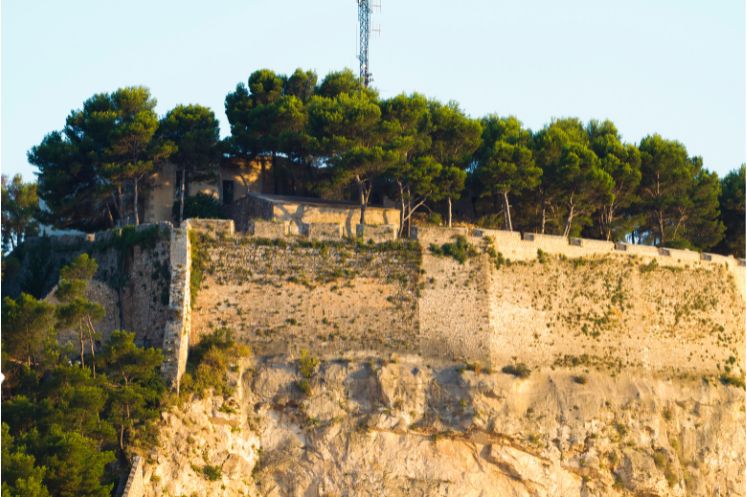Denia, a gem on Spain’s Costa Blanca, is not only famous for its beaches and gastronomy, but also for its rich architectural heritage. This historic town is a canvas of varied architectural styles, each telling a different story of the cultures that have left their mark here. From Roman vestiges to Islamic and Christian influences, Denia’s architecture offers a fascinating journey through time, inviting architects and amateurs alike to explore its most emblematic corners.
Dénia Castle
A historic fortress
Denia Castle, which rises majestically over the city, is a testimony to the Islamic past of the region. Built in the 10th century, this castle has witnessed numerous transformations over the centuries. Originally designed as a military fortress, the castle has incorporated elements from different eras, from its Islamic walls and towers to Napoleonic adaptations in the 19th century. The castle is important not only for its historical value, but also for its architecture that fuses styles and functions, offering a unique perspective on the evolution of military architecture in the region.
Contact our architectural firm
The castle today
Today, Denia Castle has become a cultural epicenter of the city. Carefully restored and maintained, the castle not only attracts visitors for its historical importance, but also for its role in contemporary cultural life. With panoramic views of the Mediterranean and the city, the castle is a favorite venue for cultural events, exhibitions and concerts, demonstrating how historic structures can be adapted to modern needs without losing their essence.
Baix la Mar neighbourhood
Charm and tradition
The Baix la Mar neighborhood, located near the port, is a charming reminder of seafaring Denia. This neighborhood, with its brightly colored houses and cobblestone streets, reflects an architectural aesthetic that has stood the test of time. The facades of the houses, painted in vibrant shades of blue, yellow and red, and decorated with wrought iron balconies, are examples of popular Valencian architecture. This neighborhood is not only a picturesque place to stroll through, but also a study of the daily life of the fishermen and sailors who once populated these streets, offering an intimate glimpse into the social and cultural history of Denia.
Gerro Tower
Defence and surveillance
The Gerro Tower is an important architectural and historical landmark in Denia. Built in the 16th century, this tower was part of a coastal defense system against Barbary pirates. Its cylindrical and robust design is characteristic of the watchtowers of the time. Located at a strategic point, the Gerro Tower served not only as a watchtower but also as a symbol of Charles I’s power and influence. Today, the tower is a popular tourist destination, offering spectacular views of the Mediterranean and coastline, and is an excellent example of how the military architecture of the past has been integrated into the modern landscape.
Ethnological Museum
A building with history
The Ethnological Museum of Denia, located in a building dating from the eighteenth century, is an excellent example of the civil architecture of the time. This museum, originally a bourgeois house, has been restored preserving its original architectural features, such as Valencian tiles and wooden beams. The building itself is a testament to Denia’s booming raisin industry, reflecting the economic boom and lifestyle of the town’s bourgeoisie in the 19th century. The museum offers a window into the past, with exhibits depicting the daily life, fashion and customs of the time, providing a historical and cultural context to the building’s architecture.
The architecture of the museum
The design of the Ethnological Museum is a clear example of Denia’s well-to-do residential architecture of the late 18th and early 19th centuries. With its elegant façade and well-preserved interiors, the museum not only preserves the material history of the town, but also serves as an educational and cultural space. The restoration of the building has been carefully managed to preserve its historical elements, while adapting it to its new use as a museum.
Other notable buildings
Architectural diversity in Denia
In addition to the buildings mentioned above, Denia is home to a variety of remarkable architectural structures that reflect its rich history. From the ancient city walls and gates to modern public and residential buildings, Denia’s architecture is a mosaic of styles and eras. Each building tells a part of the city’s story, from its origins as a Roman settlement to its development as a major port and tourist center on the Costa Blanca. Each of these buildings tells a unique story, reflecting not only Denia’s past, but also its evolution and adaptation to modern times. For those interested in exploring more about contemporary architecture and innovative projects in the city, the architects in Denia offer an expert and creative perspective, taking design and functionality to the next level.
Exploring modernity
While much of Denia’s architectural charm lies in its past, the city is also embracing modern architecture. New developments and renovations are incorporating contemporary and sustainable designs, demonstrating how the city balances its historic heritage with the needs of the 21st century. These buildings not only bring a new dimension to the urban landscape, but also reflect Denia’s continued evolution as a vibrant, modern city.


